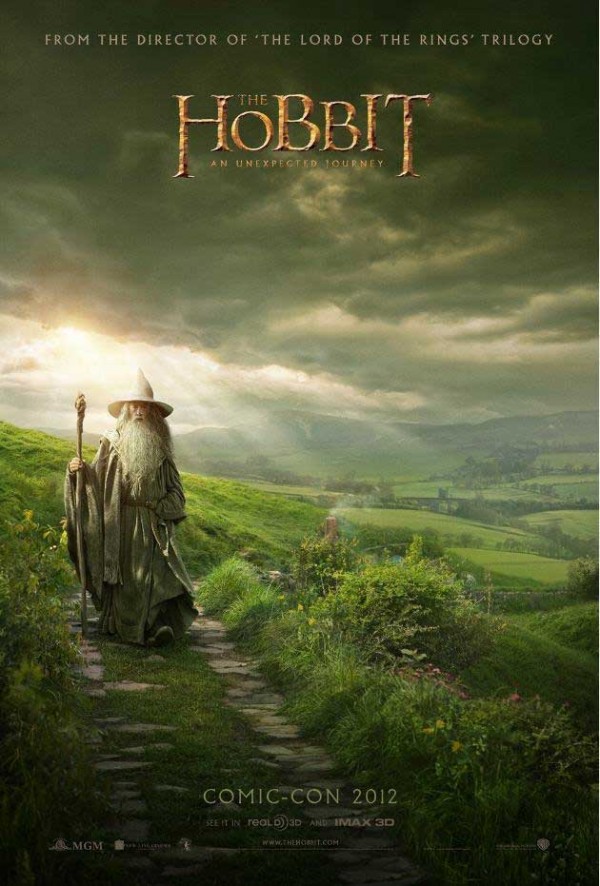THE HOBBIT: AN UNEXPECTED JOURNEY (2012, directed by Peter Jackson, 166 minutes, U.S/New Zealand)
 BY DAN BUSKIRK FILM CRITIC The Matrix sequels, The Star Wars prequels, Indiana Jones and the Kingdom of the Crystal Skull, The Godfather III; there’s something about bad prequels that make us feel uniquely superior. We know how the story should be told, we’ve seen it told well before. But there it is, up on the screen, hitting every bump and taking every wrong turn.
BY DAN BUSKIRK FILM CRITIC The Matrix sequels, The Star Wars prequels, Indiana Jones and the Kingdom of the Crystal Skull, The Godfather III; there’s something about bad prequels that make us feel uniquely superior. We know how the story should be told, we’ve seen it told well before. But there it is, up on the screen, hitting every bump and taking every wrong turn.
After topping the Lord of the Rings trilogy with a Best Picture Oscar in 2003, Peter Jackson returns to adapt J.R.R. Tolkien’s original Middle Earth tale, The Hobbit. Since the impressively mounted Rings trilogy, Jackson has directed a pair of disparate artistic failures, 2005’s bloated and ill-conceived King Kong remake and the disappointing adaptation of Alice Sebold’s morbid bestseller The Lovely Bones. Going back to Middle Earth seems like a wise retreat for Jackson yet he brings a similar tone-deaf feel for drama and pacing that has increasingly marred his work.
Rather than being an honest misfire, the circumstances that led to The Hobbit‘s special brand of God-awfulness does make it seem like a case of trying to extract too much from the goose that lays the golden eggs. The Hobbit was originally announced as a single movie, but soon expanded to two, and then three separate admissions. The sequels are scheduled to be hitting theaters in 2013 and 2014, mimicking Jackson’s Lord of the Rings trilogy. Trouble is the Rings trilogy was originally 1200 pages long, and The Hobbit, much less grand thematically and in scope, takes up a mere 300 pages. Many of The Hobbit‘s action sequences are “suggested” by notes Tolkien put in a later appendix, but shoehorning them in here does little for the film’s narrative drive.
But back to the story, slender though it is. The action starts with the humble hobbit Bilbo (Martin Freeman of the British version of The Office) finding Gandalf (Ian McKellen again) at his door with 13 dwarves in tow. Gandalf recruits the reluctant Bilbo to lead the dwarves back to their castle, where they had been vanquished by a as-yet-unseen dragon. By the time they begin their journey there is still about two hours remaining, giving them time to confront a handful of unearthly tribes through many levels, um… I mean action scenes, where fighting is indeed fierce yet sadly uninvolving. Because really, how can you construct thrilling drama out of watching Bilbo, Gandalf and the dwarves brave approximately 3000 CGI-generated “close-calls?”
The grim tone clashes with the film’s earlier moments when The Hobbit remembers that the original book was meant for children. Yet scenes like the one where the dwarves “miraculously” juggle Bilbo’s fine china with the help of computer animation seem like outtakes from the ancient Disney film, The Gnome-Mobile. What happened to the authentically antic comedic sense that Jackson originally showed in films like Dead-Alive? All along the soul-crushing three hour journey, the personal touch is absent, and the whole production feel like a corporation just threw the lever and the Lord of the Rings machinery went back to stamping out product.
Among the deadening sturm und drang, it is no surprise the film’s most-involving moments are the quietest: the meeting between Bilbo and Gollum. Set deep within his cavern lair, Gollum and Bilbo riddle face off in a battle of wits, and suddenly through Andy Serkis’ computer-abled performance the film unexpectedly springs to life. But as soon as it began it is over, and we’re back to watching rocks beat each other up and other such dramatic wonders.
The glossy icing on the cake is the film’s debut of HFR, high frame-rate technology that passes twice the amount of frames past the viewers eyes, lending to a clearer, more “life-like” image. Although the level of detail is impressive, the look is not so new, resembling the bright sheen of high-def television. There might well be good uses for this format, but the oaken hues of boggy, foggy Middle Earth seems like exactly the wrong showcase for the medium. It’s hard to discount video’s over 50-year history as the cheap sister format of celluloid film, long-used for soap operas, gaudy ’80s music videos, and bad kid’s television. Seeing a bunch of dwarves trundle around in that hyper-sheen, the crisp image catching all detail of their dyed-hair and plastic weapons, summons memories of the hokey 70s kid’s show Land of the Lost or a Saturday Night Live skit. Of course, mountains don’t need make-up, so put to IMAX type uses, the vistas are quite stunning.
Regardless of the format you see the film in, there is no pleasure to be had in a dramatic arc that randomly ends with giant bird plucking the interchangeable dwarves from their precarious perches and flying into the sunset. There, I’ve divulged the end of the film, but only because the ending makes no point, divulges no mystery nor ruins any suspense, it just comes to a halt. While breaking this story into three parts is probably the most efficient way to wrest the greatest amount of money from the world’s wallets, it makes for a lack of cinematic showmanship that should be inexcusable in the world of blockbuster spectacle. The Hobbit succeeds best in proving that telling one-third of a Tolkien’s tale is close to not telling any story at all.

